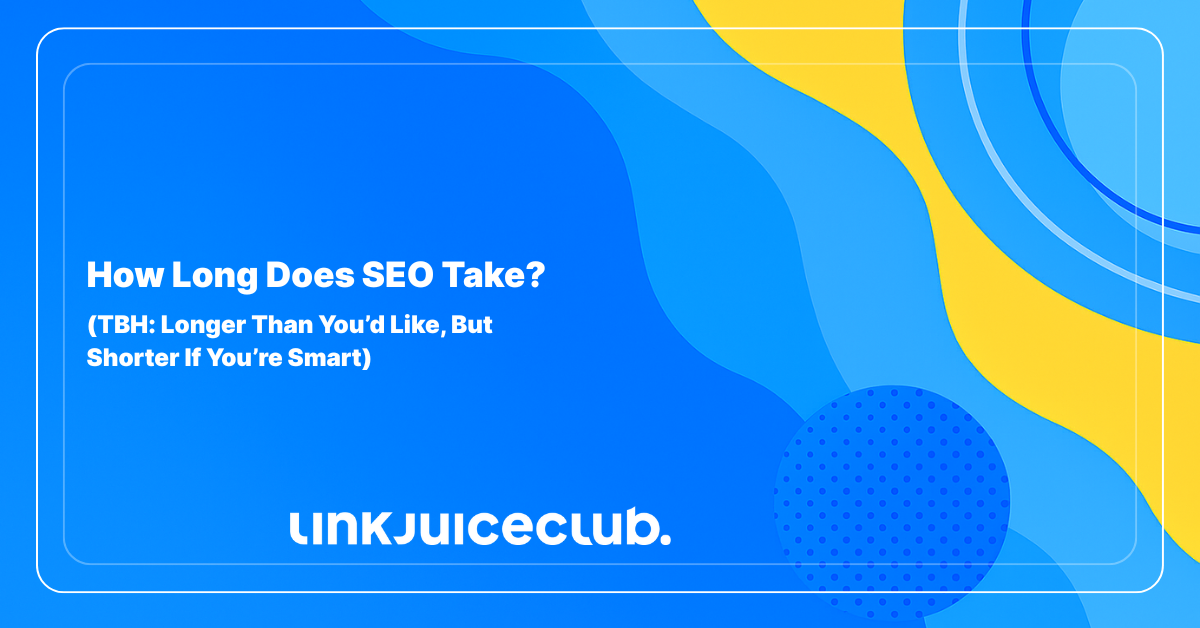
How Long Does SEO Take? (TBH: Longer Than You’d Like, But Shorter If You’re Smart)
One of the first questions that pops up faster than a spammy popup ad is: How long does SEO take to actually work?
We know it’s hard to stay patient when you’re watching your competitors seemingly leapfrog their way to Google’s front page like it’s some sort of digital trampoline.
But SEO isn’t instant ramen. It’s more like slow-roasting a brisket (worth the wait, but definitely not ready in five minutes).

What Really Impacts SEO Timelines?
SEO is a performance, and a lot of things have to line up backstage before you start hearing applause (a.k.a. organic traffic). While no two websites are exactly alike, there are recurring characters in this play.
Business Factors 📈
Behind every slow (or speedy) SEO timeline is a business reality. Here’s what’s usually in play:
1. Your Industry’s SEO Game
If you’re in a niche where competitors are still glued to billboards, great, you’ll probably rank faster. But if your space is crowded with SEO-savvy brands pumping out optimized content weekly, prepare to play the long game. Competitive landscapes matter!
2. Your Budget and Resource Firepower
No, you can’t buy Google rankings. But money does help you buy time, talent, tools, and content. Whether you’re building an in-house SEO crew or hiring the pros at Link Juice Club, the more fuel you’ve got, the faster you can drive.
3. Executive Buy-In (AKA: Does Leadership Care?)
If your CEO thinks SEO is just blogging, you’ve got a problem. True progress happens when leadership understands the long-term value and supports the process budget-wise, patience-wise, and with cross-departmental backing.
4. The KPIs You Choose to Chase
Chasing impressions when your goal is leads? That’s like tracking gym visits instead of actual gains. Your SEO timeline depends heavily on the type of success you’re measuring. Traffic might grow fast. Conversions? That’ll take more runway. Choose KPIs that match your goals—and your patience.
SEO Mechanics 🔍
So, your business is onboard, your KPIs are solid, and you have a big budget – great. Now it’s time to peek under the hood and deal with the real SEO mechanics.
1. Crawlability: Can Google Actually Read Your Site?
If Googlebot shows up and finds a bunch of 404 errors, broken scripts, or a confusing sitemap, your SEO clock won’t even start ticking. Crawlability is basically how easily search engines can navigate and index your site. No indexing = no visibility. Keep things clean, functional, and error-free.
2. Backlink Profile: Who’s Linking to You (and Are They Cool)?
Backlinks are like SEO street cred. When other trustworthy sites link to your content, Google sees that as a vote of confidence. But backlinks aren’t equal. One link from a respected publication beats a dozen spammy ones. If you want faster rankings, focus on earning high-quality, relevant backlinks. And yep, this is where Link Juice Club thrives.
3. Search Intent: Are You Actually Giving People What They Want?
SEO isn’t just about keywords; it’s about why someone’s searching. That’s search intent. Are they researching? Ready to buy? Looking for a tutorial? Align your content with what your audience really wants to find, not just what they’re typing. Do that right, and Google rewards you with faster visibility.
4. On-Page Optimization: Sprinkle That SEO Dust (Strategically)
Meta tags, headers, internal links, alt text, schema markup, this is the nerdy backbone of every SEO-friendly page. But don’t overdo it. Every well-placed keyword or link gives your site a stronger foundation to climb the rankings ladder.
5. Keyword Competition: Go Where the Giants Aren’t
If you’re aiming to rank for shoes, good luck… You’ll be swimming with Nike and Zappos. But vegan hiking shoes under $100? Now we’re talking. Long-tail keywords are your shortcut to quicker wins. They’re less competitive, more specific, and often more aligned with buyer intent. Win-win-win.
6. Core Web Vitals: Is Your Website a Smooth Ride?
Slow sites sink. Clunky designs lose users. Bad UX? Google notices. Core Web Vitals are Google’s way of measuring how pleasant your site is to visit. This is all about speed, stability, and responsiveness. Keep things snappy, mobile-friendly, and bug-free. Regular technical SEO audits will help you fix bottlenecks before they hold you back.
SEO Timelines Aren’t Made for the Impatient
SEO doesn’t sprint; it climbs. Carefully, deliberately, and with a plan. If you’re expecting instant results, you’re chasing the wrong strategy.
First, your team needs to dig deep into your business, your niche, and the battlefield you’re trying to win. That means audits, research, competitive analysis, and content strategy.
Then comes the rollout. Content has to be created, optimized, and published. Technical tweaks have to be implemented. And after all that, Google still needs to crawl, re-evaluate, and decide where you now fit in its ranking universe.
The truth is: just because you’ve done the work doesn’t mean Google owes you a top spot. It watches. It waits. It compares. That lag is part of the game. Many brands panic and pull the plug at the three-month mark, assuming SEO didn’t work. In reality, they quit right before the engine kicked in.
So… How Long Does SEO Take?
Asking the question how long does SEO take is like asking how long it takes to get fit.
The answer is that it depends on where you start, how hard you work, and what your goals are. Some sites see traction in a few months. Others take six to twelve before things start compounding. But every legitimate SEO effort lays down bricks for long-term growth: no shortcuts, no hacks.
And if you want to speed things up the right way, Link Juice Club is your secret weapon. We specialize in two of the most critical pieces of the SEO puzzle: powerful content that actually ranks, and premium high-authority domains. If you’re ready to start climbing, hit us up!





